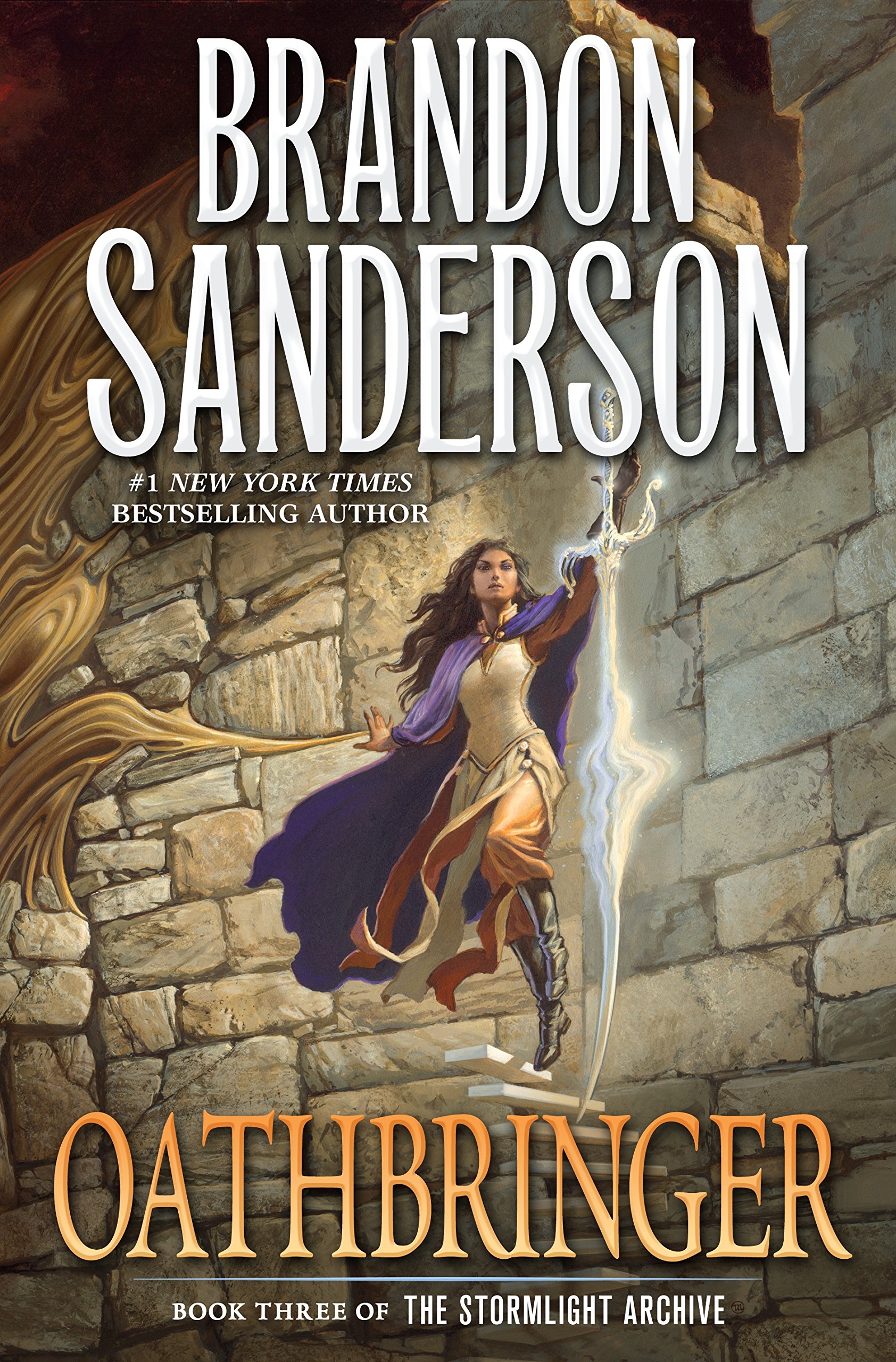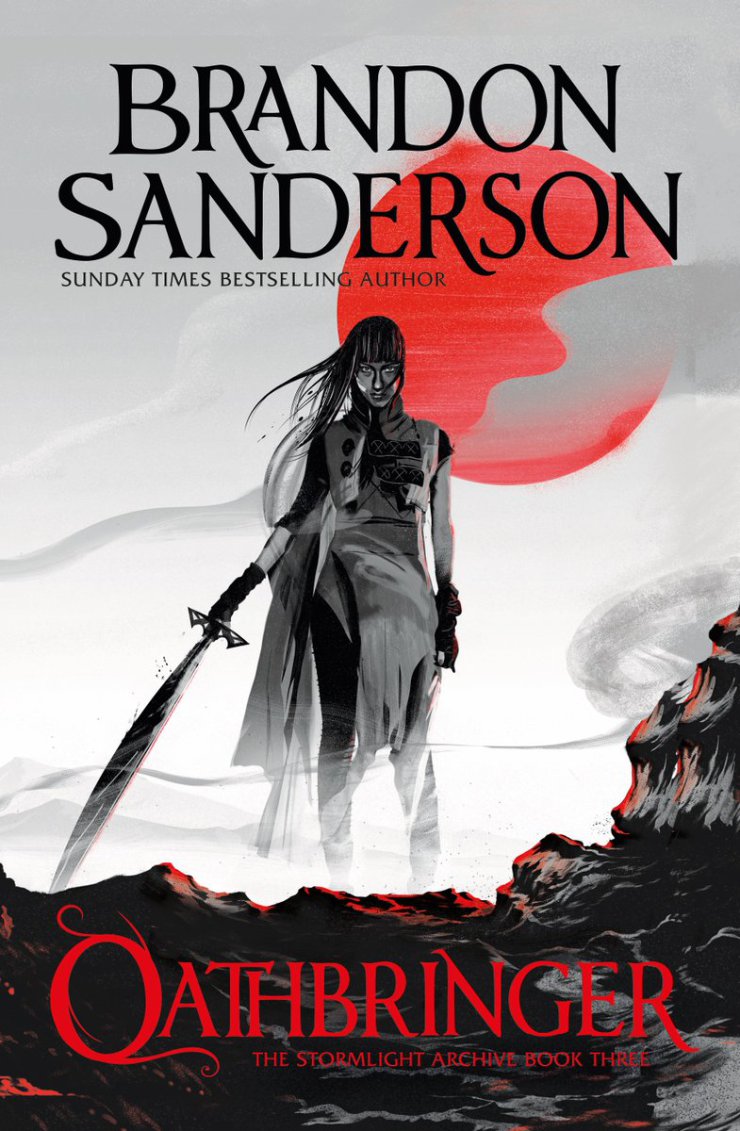Oathbringer (2017)
Author: Brandon Sanderson
Narrated by: Kate Reading, Michael Kramer
Genre: Epic Fantasy
Series: The Stormlight Archive (Book 3)
Length: 1,248 pages (Kindle); 55 h and 4 m (Audiobook)*
Publisher: Tor Books
Why I Chose It: I read Oathbringer as part of 2018’s Resolution Project. Also, I’m a big fan of both the series and the author.
The Premise:
Oathbringer, the third volume of the New York Times bestselling Stormlight Archive, humanity faces a new Desolation with the return of the Voidbringers, a foe with numbers as great as their thirst for vengeance.
Dalinar Kholin’s Alethi armies won a fleeting victory at a terrible cost: The enemy Parshendi summoned the violent Everstorm, which now sweeps the world with destruction, and in its passing awakens the once peaceful and subservient parshmen to the horror of their millennia-long enslavement by humans. While on a desperate flight to warn his family of the threat, Kaladin Stormblessed must come to grips with the fact that the newly kindled anger of the parshmen may be wholly justified.
Nestled in the mountains high above the storms, in the tower city of Urithiru, Shallan Davar investigates the wonders of the ancient stronghold of the Knights Radiant and unearths dark secrets lurking in its depths. And Dalinar realizes that his holy mission to unite his homeland of Alethkar was too narrow in scope. Unless all the nations of Roshar can put aside Dalinar’s blood-soaked past and stand together — and unless Dalinar himself can confront that past — even the restoration of the Knights Radiant will not prevent the end of civilization.
There are no plot spoilers in this review, although I do comment on specific character journeys for those of you who would like to remain completely spoiler-free.
Discussion: The fact that this book is well over 1,200 pages may seem a little ridiculous.
Most novels, even in the epic fantasy genre, really don’t need to be that size. Once you start to get to that doorstopper length, things tend to feel bloated by default. There are too many characters to follow, coupled with too little plot progression. This is something that books like Oathbringer — middle volumes in a series — seem to struggle with the most, where the massive weight of the story begins to spiral outside of the author’s control. And perhaps the most satisfying thing about Oathbringer is fact that Brandon Sanderson manages to sidestep so many of these typical issues to deliver one of the strongest books in The Stormlight Archive series.
So what works so well about Oathbringer, and The Stormlight Archive as a whole? The plot is pretty much what you’d expect for an epic fantasy: A great evil is coming (Odium), and our super powered heroes must gather together to stop him. If they fail, it will mean the end of the world. Some people might scoff at Sanderson for using such standard fantasy tropes, but they actually work really well here. By basing this epic novel on more conventional tropes, he gives readers something familiar to hang onto as he delves into the complex cultures of Roshar and its interrelated magic systems. And, as Oathbringer ends up showing us, the way which he chooses to subvert some of those tropes end up being some of the more fascinating points of the book.
 Not mention the time it allows him to spend on developing these wonderful characters, the true crux of the novel.
Not mention the time it allows him to spend on developing these wonderful characters, the true crux of the novel.
While Kaladin has arguably been the protagonist of The Stormlight Archive thus far, Oathbringer eases off the likable bridge boy in favor of two other characters: Dalinar and, to a lesser extent, Shallan. Dalinar is truly the hero of Oathbringer, which is ironic because for a large chunk of the book, he ends up looking very un-heroic. Each book in The Stormlight Archive has a series of flashback scenes that explains a specific character’s back story. This time around, these flashbacks are Dalinar’s returning lost memories. And let me tell you, his memories show us a different side of the honorable man we have come to know and love over the span of two books.
Showing us this long-lasting character growth, over the span of multiple decades, displays the value of having a protagonist beyond the typical teenage to mid-twenties age range that we often find in fantasy novels. Doing so allows us to examine a very different, but equally satisfying character journey — a coming of middle age, if you will. In order for Dalinar to succeed, he must accept all of the different roles that he has played throughout his 50+ years, the good, the bad, and the downright awful. And only then can he be allowed to grow and save the world.
Interestingly enough, Dalinar’s character arc is somewhat echoed in Shallan’s. In previous volumes, we’ve seen how Shallan has used lightweaving (a magic system that creates illusions so complex that they become real) to create an alternate personality for herself named Veil. In Oathbringer, she takes this a step further, fracturing her personality into three. Shallan struggles with these multiple roles and motivations she finds in herself. For those of you looking for a Kaladin-Shallan-Adolin love triangle, this is where you find it. For those of you less thrilled by the prospect, you’ll be happy to see that it’s mostly an internal struggle and not marred by the more frustrating tropes that can often be found in such instances. Similar to Dalinar, Shallan must begin to accept painful truths about herself if she’s to determine what she really wants in life.
Fortunately, while Kaladin may be the third most important character this time around, that doesn’t mean that his material is bad. In fact, Oathbringer contains vital moments for Kaladin that we have been building towards since The Way of Kings. The first (which readers will probably be able to guess from how Words of Radiance ended) is reuniting with his estranged family, which is just as powerful and emotional as you’d expect. There is a second similarly powerful moment that happens much later in the book, but I won’t spoil it for you. With Kaladin especially, I ended the book quite excited for developments that are clearly coming for him in the future.
Notes on the Audiobook: Oathbringer has two narrators, with Michael Kramer narrating the chapters centered around a male character, and Kate Reading reading the more female focused characters. Both narrators did a stellar job, creating subtle, but noticeable differences between the different character voices. On a rare occasion, I did experience a slight disconnect going from one chapter to the next, as the voices one narrator might use for a character didn’t always line up with the other’s choice. But to be honest, given the large cast of characters, it’s kind of surprising that I didn’t experience it more often (this was only ever a real issue with Adolin). Beyond this small issue, I felt like each narrator did a great job, and I am glad they they were chosen to narrate Oathbringer.
In conclusion: As you might expect from such a lengthily tome, what I’ve written really only scratches the surface. It would be unfair to call Oathbringer perfect (perhaps it’s a result of these books coming out so far apart, but I struggled with some of the material related to the heralds), but I really loved reading it. The novel hits every emotional beat that I desire from my epic fantasy. I was always excited to see what our characters would discover next, and there were some moments when I was genuinely moved to tears. Oathbringer is a great addition to Brandon Sanderson’s The Stormlight Archive, and a reminder to people like myself that yes, some books really need to be in excess of a thousand pages. Given the complexities of the characters, and Oathbringer‘s epic scope, it just makes sense. But if you’re going to write a tome this long, you’d be remiss not to look towards books like Oathbringer. It may expect a big time commitment from its reader, but it earns every hour of it.
* = I experienced half this book in Kindle format, and half as an Audiobook using the Whispersync function.

[…] via Epic Characters, Epic Page Count: A Review of Oathbringer — Speculative Chic […]